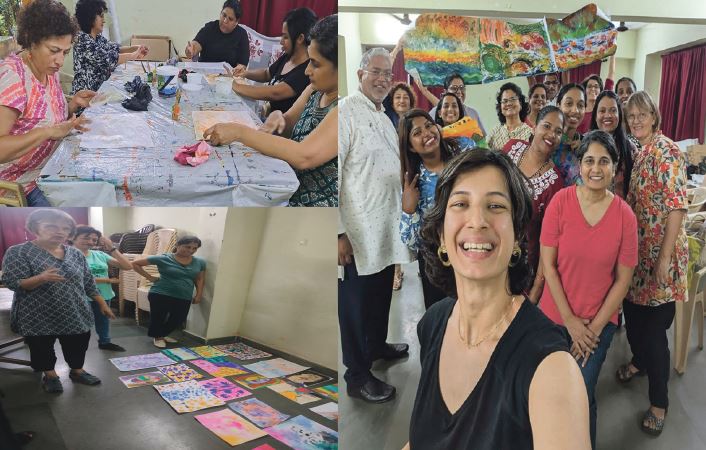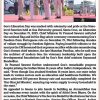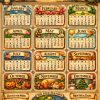Goa is abuzz with excitement as vintage bike and car owners, users, collectors and fans are decking […]

HEALING BRUSH STROKE BY BRUSH STROKE!By Aileen Carneiro
Feb 08- Feb 14 2025, Life & Living February 7, 2025ART is liberating! I’ve learnt that every scribble, every stroke, every choice of colour can have a lot of depth, our past and present all rolled into one.” Nutritionist Jeanne Ribeiro was one of the participants at the recently concluded 10-day certified course titled “Art as a Healing Tool” organised by Caritas Goa, and guided by artist and art facilitator Lioba Knepple. Ribeiro took the opportunity to get out of her comfort zone, face the stresses of life head-on with a paint brush, and, like all the other participants, began to really look forward to art Saturdays.
However, paint brushes were not necessarily the star of the show. “I enjoyed the use of different tools that are so easily available at home, items that we would most often throw out,” she added, referring to the somewhat unconventional upcycled items that found their way into the participants’ hands to create art with.
“The workshop was incredibly engaging, and I loved experimenting with different colour blending techniques,” says Special Educator Nandadeep Naik. “The instructor was inspiring and made the process easy to follow.” Several other participants were also educators working with special needs children, and had already begun applying the learnings from the course into their work with their students. Mira Shanti Naik, also a Special Educator, shares, “We were being introduced to new methods and styles of painting. Whether it’s mixing paint, layering colours, or experimenting with different materials, a key part of the experience was self-expression.”
GOLDEN RULE
INDEED, this self-expression often emerged from a bit of chaos. Ignoring the “golden rule” we’ve all been taught as kids to “colour inside the lines,” participants were encouraged to make a huge mess on their medium, which ranged from paper to canvas. Naturally, this was challenging for some at the beginning. But as is often true with our lives, beauty can also be wrought out of the so-called mess in art. “There is no `wrong’ in art. There is always room for correction,” says Enid Varela, who runs a printing business.
In fact, like many others, Special Educator Rupali Malwankar found the experience to be relaxing and help release one’s inner feelings. “There were no restrictions on how to paint and even the messy paintings would turn out to be beautiful,” she says. Her sentiments are shared by Joyella Monteiro, office staff at Caritas Goa. “I always believed that art had to be perfect to be called beautiful. But in our sessions, the word “perfection” was omitted,” Monteiro says. A pivotal aspect of the experience was the process of “unlearning to learn” or “learning to unlearn.” The belief in needing to be ‘talented’ was gradually shown the door. This learning proved enriching for Special Educator Pooja Naik. “I realised that art is not just about talent but also about expression. It has taught me to embrace imperfection and find calm in moments of stress,” she shares. Special educator Sapna Gawas also found her beliefs challenged in the course of the workshop. “I have experienced a lot of change in my thinking. I’ve learnt that painting is a great way to release these inner thoughts.”
The vibe in the room can make or break a shared experience, and the art workshop turned out to be a sanctum of positivity. “There was a good rapport among the participants and a friendly and jovial atmosphere prevailed,” Special Educator Marinelle Filinto points out. “Here you could draw freely. There were no expectations. The feedback and the encouragement from Lioba were awesome,” she adds.
STORY POTENTIAL
THIS “safe space” paved the way for candid, vulnerable, heartfelt sharing sessions at the end of each day. “It was a moment for each participant to share their work, provide and receive feedback from each other and reflect on the experience,” adds special educator Mira Shanti Naik. “The conversations and discussions about our art were carried out with no judgement,” Nutritionist Ribeiro adds, “And each time you look at it, you’ll find something new that you didn’t see before.” This was in fact an eye- opening experience for homemaker and language specialist Aileen Carneiro, who had produced in one of her artworks a character from a movie she had watched that morning, without the slightest intention to or clue that she had done this, and which was picked up by another participant browsing her piece. “I often didn’t finish my artwork on time, but realised that even an unfinished piece has the potential to tell a story,” Carneiro says.
The fruit of the experience also found expression in these sharings. “The sessions were therapeutic,” says Monteiro, who finds that her mind is now more at ease and that a good night’s sleep comes to her more easily. “I’ve become more patient and I look for something good in the worst scenario.”
Home-maker and teacher Ginevra M Pereira joined the course in the hope of finding some space for herself in the chaos of life. “Lioba has taught us that we need to feel the art, the emotion that comes with it, and to stop thinking about what to draw.” The healing it has brought her has helped her deal better with the loss of her dad. It has also given her a new avenue for bonding with her daughter. “My ever-energetic seven-year-old and I already have our connect, but through art the rapport is on a different level, as we now dabble with paint before bedtime, sharing thoughts and emotions, resulting in better, peaceful rest and sleep. Outcome? We’re all happy and set the next morning to take on a new day!”
The participants came to the workshop from far and wide. Counsellor Carol Antao who drove up all the way from Raia sums up the experience, “In Lioba’s art sessions it was so refreshing to unlearn the need to follow rules and instead, go with the flow, let go of control and let the creation take over. During this time together, a safe space to explore and `go within’ was nurtured and encouraged which was deeply relaxing and peaceful.”















